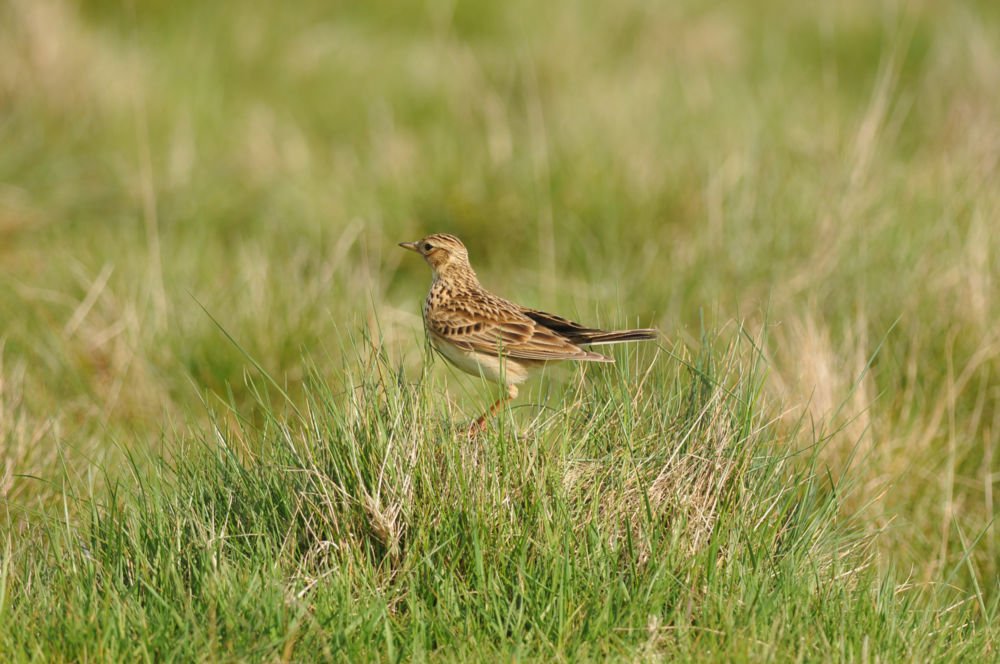Photo: Skylark, courtesy of The Royal Parks
Ron Crompton to step down as Chairman
 Ron Crompton is stepping down as Chairman of the Friends at the AGM in April. He became Chairman at the AGM in April 2007, succeeding John Collier, and has successfully led and developed the Friends over the last fourteen years, especially in areas such as volunteering, conservation projects, campaigning and greater communications including social media. He will continue to be involved in the Friends on specific projects and has agreed to be a Vice-President. He’ll talk about his time as Chairman in an interview in the Spring newsletter, that will be sent to members at the end of March.
Ron Crompton is stepping down as Chairman of the Friends at the AGM in April. He became Chairman at the AGM in April 2007, succeeding John Collier, and has successfully led and developed the Friends over the last fourteen years, especially in areas such as volunteering, conservation projects, campaigning and greater communications including social media. He will continue to be involved in the Friends on specific projects and has agreed to be a Vice-President. He’ll talk about his time as Chairman in an interview in the Spring newsletter, that will be sent to members at the end of March.
Subject to approval by the AGM in April, Ron will be succeeded by Roger Hillyer, who is currently our Honorary Secretary and a Trustee. Roger has been a member for many years, lives in East Sheen and is a regular visitor to the Park, both as a walker and leisure cyclist.
Skylarks, Clare Balding and the BBC
See the Friends’ new film Protecting the Skylarks in Richmond Park, presented by Clare Balding
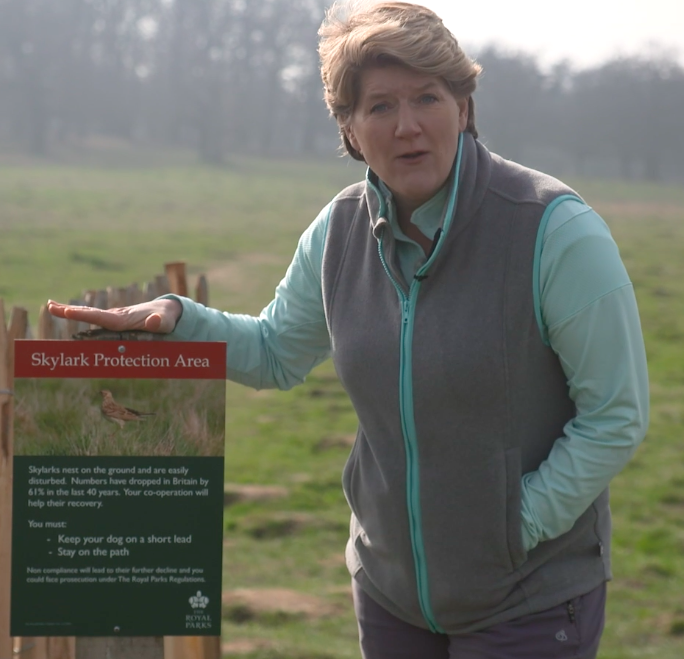 The skylark breeding season started in late February and in the Park some fencing panels and notices are in place at Lawn Field (between Lower Pen Pond and the Ballet School) and Crown Field (the other side of Beverley Brook from Roehampton Gate car park) asking people to keep to the paths and keep dogs on leads. Please get the message out to your family and friends and to others you meet, especially fellow dog walkers.
The skylark breeding season started in late February and in the Park some fencing panels and notices are in place at Lawn Field (between Lower Pen Pond and the Ballet School) and Crown Field (the other side of Beverley Brook from Roehampton Gate car park) asking people to keep to the paths and keep dogs on leads. Please get the message out to your family and friends and to others you meet, especially fellow dog walkers.
We were filming a new Skylarks film, presented by our Patron, Clare Balding, when the BBC London news team turned up to film the Friends filming. Their report was on Monday’s evening news. you can see it here and read about it on the BBC News website. Our film should be ready to view next week and we’ll be sending a Special Bulletin with a link to it.
Friends volunteers to re-start and Visitor Centre re-open
In line with the government relaxing of lockdown restrictions, the Friends plan to re-start our volunteering soon. Adopt-an-Area will re-start next week (8 March) and our conservation volunteers after 29 March when the ‘rule of six’ comes into force. Also from 29 March, the Visitor Centre will re-open for information only with a table across the door and fully-re-open for sales of merchandise from 15 April (with mask wearing and social distancing). As yet we have no plans to re-start our monthly walks or Discoverers. We’re pleased to say that the Royal Parks Community Rangers will also re-start next week.
Bag it, bin it, take it home!
Calling our young artists! There is still time to enter Discoverers anti-litter poster competition. There are several age categories from under 7s to 18 yrs. Winning posters will be reproduced and displayed on notice boards all around the Park to help tackle this growing problem. The closing date for entries has been extended to 15 March.
See full details here and how to enter.
Primary School teachers needed for new children’s booklet on the Parks’ trees
The Friends are producing a 32-page booklet on Richmond Park’s trees and the wildlife that lives on them, for children 7 to 11 years old. We already have a draft outline and lots of ideas about illustrations and layout. We now need primary school teachers to guide us, by email and occasional zoom meetings, starting in March. Please email Vivienne Press at editor@frp.org.uk if you would like to be involved.
Book now for the AGM 2021
Our 2021 AGM will be on Saturday 24 April 2021 at 11.00am. by Zoom. Members will receive more information, including our Review of 2020, in an insert in the printed Spring Newsletter. While there will be some formal business, the large majority of the meeting will be devoted to a report on the current activities of the Friends and an opportunity for members to ask questions and discuss what is happening in the Park. Please note it will be members only. If you wish to attend, please register using Eventbrite https://frp-agm-2021.eventbrite.co.uk where you will have an opportunity to provide a question to the trustees. If you are not a member and would like to join the Friends, please click here
Photography competition – The Trees of Richmond Park in Spring
Free entry. Open now. Closing date 31 May 2021
As part of the Year of the Tree, the Friends of Richmond Park are running a series of seasonal photography competitions. ‘Spring’ is the last one, postponed from last year due to Covid restrictions. The overall theme is images that show the character of the Park’s trees. Images can be of any part of a tree, whole trees or groups of trees. Entrance is free.
See here for details of how to enter, the prizes and Terms and Conditions.
50 Richmond Park videos
We are building a library of videos about Richmond Park on YouTube. There are now over 50 videos, including the Friends’ award winning Richmond Park: National Nature Reserve, presented by Sir David Attenborough. See the videos here
Calling for photos for the 2022 Friends’ calendar
We are now inviting photos of Richmond Park for the Friends’ 2022 calendar. Please see www.frp.org.uk/calendar2022 for details of how and where to send them. Closing date 25 April. We look forward to seeing your amazing images – a maximum number of 8 photos from each photographer, but not more than 4 from any one season: winter, spring, summer, autumn. The 2021 calendar sold out and raised a record amount for projects in the Park. We are very grateful to all who donated their photos.
Richmond Park Walks with Remarkable Trees
Available to buy now!
The first and second sets of our very popular self-guided tree walks are now on sale for delivery by post, for £5 each set + p&p. Download the order form here.
Discover the diversity and majestic beauty of some of the Park’s most interesting trees and also have a good walk in areas you may not otherwise get to see.
All the walks are circular routes starting from a car park and between 2 and 5km long. Each walk is in its own easy-to-use 12-page booklet with many helpful photos. We have received lots of excellent feedback: “Brilliant, well written, superbly laid out, good levels of information”; “I love it so much I would like to order another for my family”.
Dog owner fined over deer stampede that injured boy
A Weybridge man was fined £865, with £165 costs and victim surcharge, at Wimbledon magistrate’s court last month. His dog, a Rhodesian Ridgeback chased a herd of deer in Bushy Park causing one of the animals to run towards a father and three children who were on bikes. The deer attempted to jump over the family but struck the boy causing him injuries that needed hospital treatment. This incident took place in Bushy Park, but in January another man was fined for letting his Red Setter off lead in Richmond Park. The dog attacked a deer which was hit by a car, trying to escape, and had to be put down.
Richmond Park Police confirm the following between April and December 2020:
- 991 verbal warnings for ‘Dog off-lead/failure to control animal’
- 161 Park Regulation 3(5) breaches (name taken etc.) for ‘Dog off-lead/failure to control animal’
- 23 Park Regulation 4(21) breaches (name taken etc.) for ‘Dog chasing/worrying deer’
New edition of The Birds of Richmond Park
The latest updated edition of the The Birds of Richmond Park, listing 174 different bird species spotted in the Park over the last 10 years, is now published. It gives guidance on whether the birds are resident, summer or winter visitors, or if they are rare species in the Park. Compiled for the Richmond Park Bird Group by Nigel Jackman. Sources: Richmond Park Bird Group and London Natural History Society records.
Rare visitors to Pen Ponds
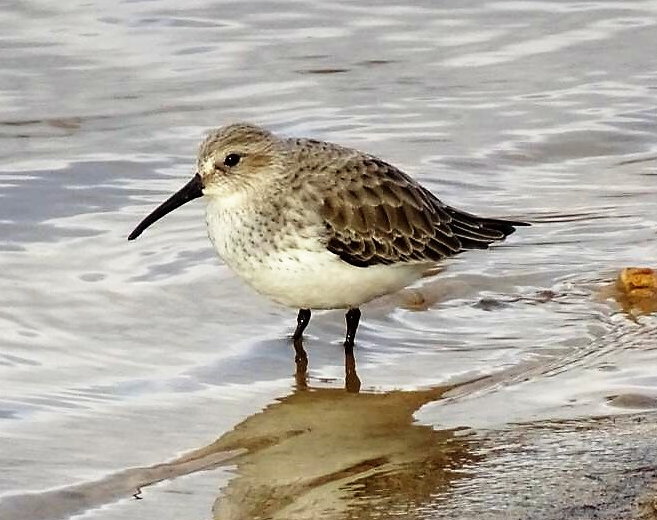 After an absence of any notable winter visitors to the Pen Ponds a Dunlin, one of our smallest common waders, was seen and photographed at Upper Pen Pond one day in the middle of February. Although found in large numbers around the coast at this time of the year, a Dunlin is a rare occurrence in Richmond Park and this was only the fifth sighting in more than thirty five years.
After an absence of any notable winter visitors to the Pen Ponds a Dunlin, one of our smallest common waders, was seen and photographed at Upper Pen Pond one day in the middle of February. Although found in large numbers around the coast at this time of the year, a Dunlin is a rare occurrence in Richmond Park and this was only the fifth sighting in more than thirty five years.
Dunlin, photo by Sandra Hucks
Each winter there is an influx of Woodcock from Russia, and occasional surveys of numbers are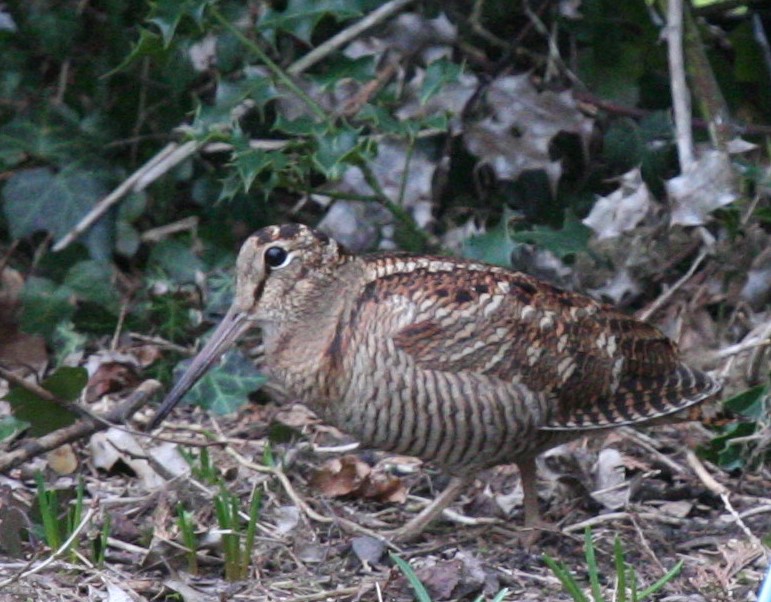 undertaken in the Park. On a January evening two years ago an exceptional number of eighteen of these birds were seen at dusk leaving four woodland areas, their daytime roosts, to feed. The Park is by far the most important known wintering location for Woodcock in Greater London and the London Bird Club has now confirmed that this count appears to be the highest from one site in the London Area (within a 20 mile radius of St Paul’s Cathedral) since 1880.
undertaken in the Park. On a January evening two years ago an exceptional number of eighteen of these birds were seen at dusk leaving four woodland areas, their daytime roosts, to feed. The Park is by far the most important known wintering location for Woodcock in Greater London and the London Bird Club has now confirmed that this count appears to be the highest from one site in the London Area (within a 20 mile radius of St Paul’s Cathedral) since 1880.
Woodcock, photo by Julian Thomas
New fence at Adam’s Pond
The new metal fence around Adam’s Pond is part of the restoration of the pond and intended to keep out the deer and dogs. There are gates for people to go inside and sit. Wire will be added to the bottom section to keep out small dogs. The fencing is currently silver but will be painted Royal Park’s dark green colour later.
Guided Walks
Most of our guided walks in 2020 had to be cancelled due to Covid. This year, the January to March walks were cancelled, and we now have to cancel the April walk, but hope to re-start the walks in May. Since government restrictions are under constant review and subject to change, we will update the guided walks webpage ahead of each walk. Please check in advance before attending.
Richmond Park Diary
©TRP
Lockdown easing
The winter lockdown starts to ease on 8th March when schools return. But with shops, hospitality and sports venues still closed, and the spring weather improving, the park will continue to be busy especially at peak times. The earliest significant change to the park operation will not occur until at least 12th April when outdoor seating in food establishments can return. This will mean that picnic benches can return to the park but also, we may find the park starts to get a little less busy as people could also choose to visit pubs (outdoors) shops, gyms and hairdressers or meet with a limited number of friends in private gardens.
Dog identification
The media has reported that the last years change in working habits has resulted in an increase in dog ownership, rise in value for a new puppy and an increase in dog thefts. Whilst this might be worrying for dog owners it also reminds long-standing dog owners of their responsibilities. It is not uncommon for dogs and their owners to become separated. When this happens a member of the public inevitably notices the dog and helps.
If the dog has a collar and tag with a mobile phone number, the incident is very quickly resolved, but relying on the security chip alone is not sufficient. The dog will need to be taken to a vet or borough council dog warden who have a scanner to read the chip. They can then trace the contact details on ‘the system’ at the time the dog was registered – that may have changed.
The time inconvenience and reliability of tracing the owner inevitably delays the return of the dog. Occasionally it can take a few days, incurring kennelling costs and resulting in separation anxiety for the dog. Owners are therefore required to always have a tag on their dog and it’s sensible to keep a spare in case the tag gets lost.
Nesting birds
The courtship behaviour of breeding birds is starting to become evident and skylarks are performing their fantastic displays in various locations. As ground nesting birds they are particularly vulnerable to disturbance. Dogs have a habit of running randomly away from paths and so the dogs on leads zones have been implemented from 1st March.
Last year around 18 skylark territories were identified across the park. The increase in visitor numbers during lockdown has the potential to increase the levels of disturbance to these vulnerable and rare birds. It is particularly important to be sensitive to wildlife and observe the signs during this difficult period.
Toad in the road (and frogs and newts!)
If you cycle through the park at night, please watch out for amphibians on the road when it is wet. Frogs, toads and newts come out of hibernation to mate in the parks ponds and they cross the road very slowly. If the weather has been dry and/or cold, the 1st wet mild evening in spring will see them emerge. Frogs and toads look much like leaves and newts look much like a small stick – please be careful not to squash any!
The Isabella Plantation in March
©TRP
Camellias
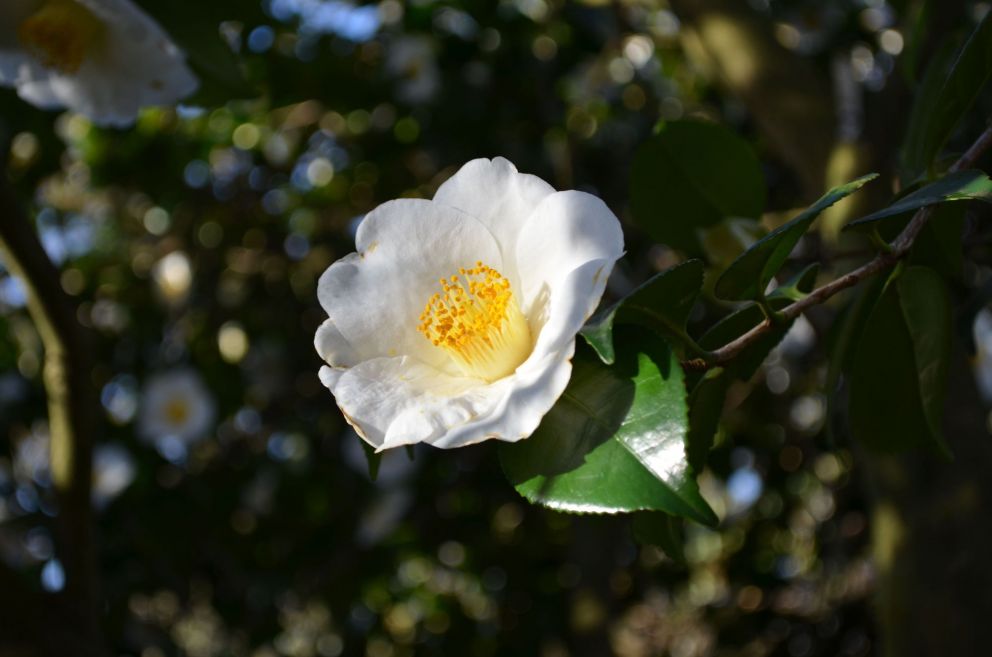 Following the path which runs through woodland up the western side of the Garden you will find two of the many famous williamsii hybrid camellias: Camellia ‘Donation’, and C. ‘Inspiration’ near the ancient pollard oak. Nearby, the formal double white flowers, striped with red and pink, belong to Camellia japonica ‘Lavinnia Maggi’. Camellias frequently produce ‘sports’, and you may find white, red and striped flowers all on the same plant. Camellia japonica ‘Preston Rose’ also grows in this area and bears salmon- pink paeony form flowers.
Following the path which runs through woodland up the western side of the Garden you will find two of the many famous williamsii hybrid camellias: Camellia ‘Donation’, and C. ‘Inspiration’ near the ancient pollard oak. Nearby, the formal double white flowers, striped with red and pink, belong to Camellia japonica ‘Lavinnia Maggi’. Camellias frequently produce ‘sports’, and you may find white, red and striped flowers all on the same plant. Camellia japonica ‘Preston Rose’ also grows in this area and bears salmon- pink paeony form flowers.
Camellia ‘Parkside’ another williamsii hybrid bearing an abundance of large clear pink semi double flowers grows in Magnolia grandiflora Glade set back from Thomson’s Lawn. Another garden favourite, Camellia Japonica ‘Alba Simplex’ shows large white flowers with conspicuous yellow stamens and grows in many spots around the garden, including set back at the top of the main stream path.
Three Wilson Plants
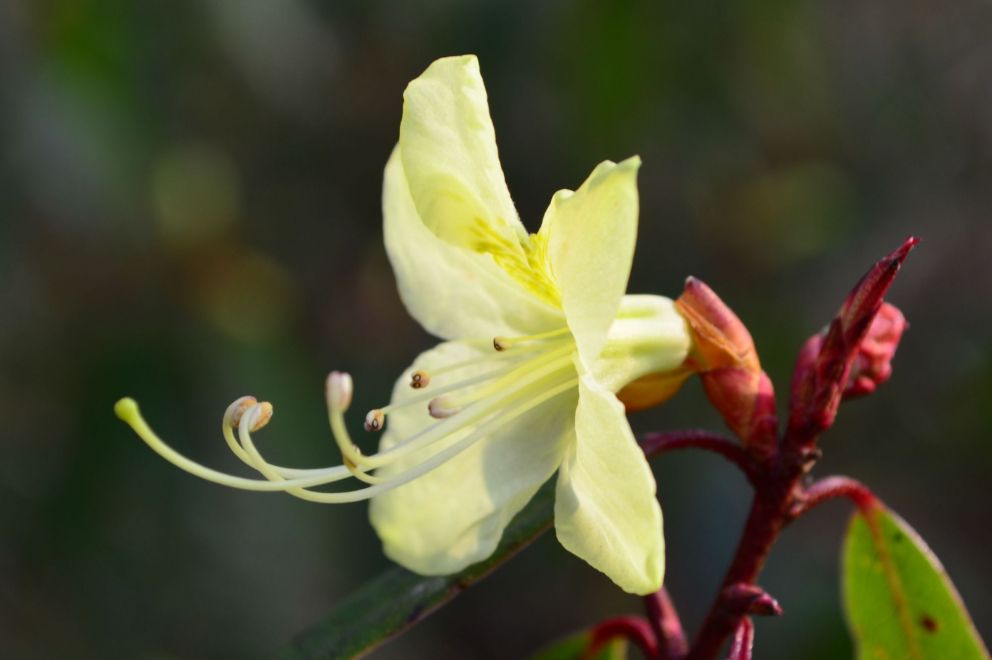 Rhododendron lutescens, is an early-flowering rhododendron species from China, small leaves and primrose yellow blooms. Many of these plants grow set back to the east of the Main Stream. More, younger plants grow near the fence in Wilson’s Glade. Wilson’s Glade is situated to the north of the entrance gate from Broomfield Hill car park. It houses a collection of plants introduced to this country by the famous plant collector, Ernest Wilson. Also near the fence of the glade is a group of Stachyurus chinensis, a shrub with long drooping racemes of soft yellow flowers. Close to the main path through the glade is Corylopsis veitchiana, a large erect growing shrub that also bears its flowers in large racemes of primrose yellow with conspicuous brick red anthers.
Rhododendron lutescens, is an early-flowering rhododendron species from China, small leaves and primrose yellow blooms. Many of these plants grow set back to the east of the Main Stream. More, younger plants grow near the fence in Wilson’s Glade. Wilson’s Glade is situated to the north of the entrance gate from Broomfield Hill car park. It houses a collection of plants introduced to this country by the famous plant collector, Ernest Wilson. Also near the fence of the glade is a group of Stachyurus chinensis, a shrub with long drooping racemes of soft yellow flowers. Close to the main path through the glade is Corylopsis veitchiana, a large erect growing shrub that also bears its flowers in large racemes of primrose yellow with conspicuous brick red anthers.
Magnolias
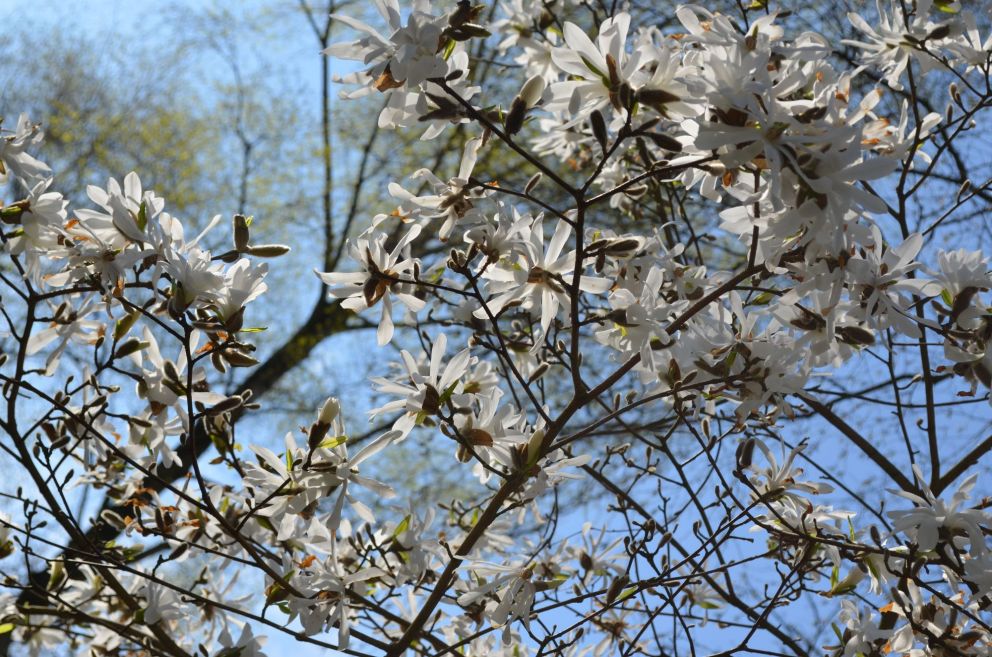 During March several magnolias come into flower. A fine Magnolia stellata stands near the path above Thomson’s Pond. Many others are planted throughout the Garden, particularly in woodland areas on the western side. Two young Magnolia x loebneri ‘Leonard Messel’ can be found growing in Bluebell Walk opposite Acer Glade. This large shrub or small tree bears lilac-pink flowers that are deeper in bud. A more mature form can be found growing on the other side of Acer Glade.by the Scots Pine
During March several magnolias come into flower. A fine Magnolia stellata stands near the path above Thomson’s Pond. Many others are planted throughout the Garden, particularly in woodland areas on the western side. Two young Magnolia x loebneri ‘Leonard Messel’ can be found growing in Bluebell Walk opposite Acer Glade. This large shrub or small tree bears lilac-pink flowers that are deeper in bud. A more mature form can be found growing on the other side of Acer Glade.by the Scots Pine
Narcissi
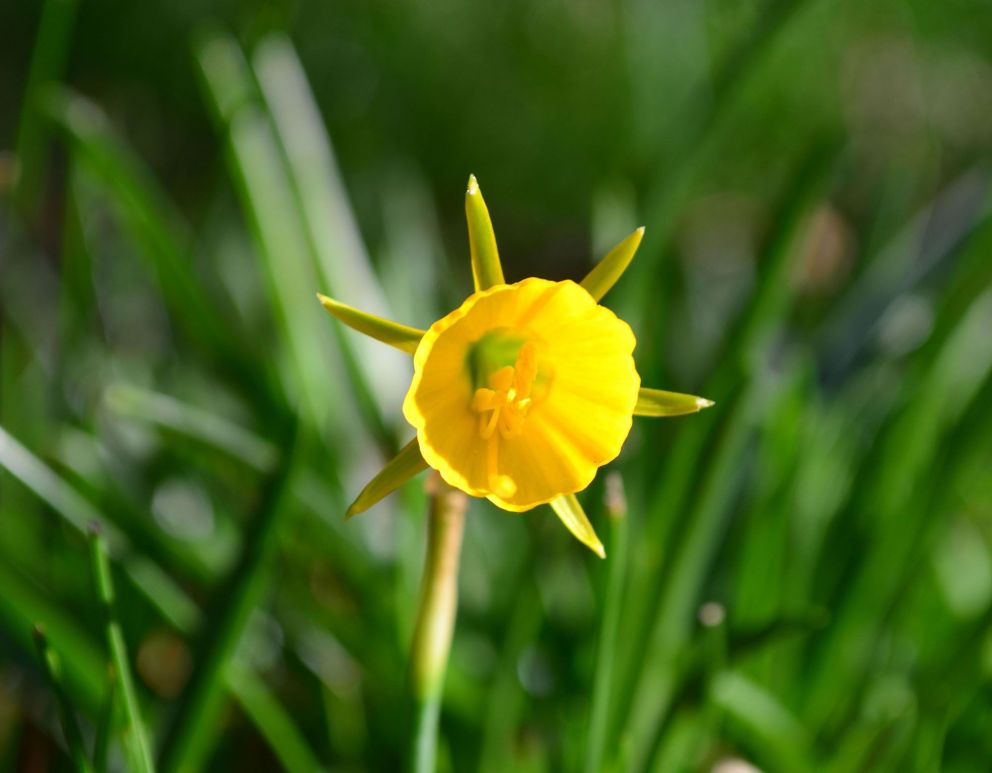
Growing on the wet lawn near the gate from Broomfield Hill car park, the dwarf Narcissus cyclamineus, native of Spain and Portugal, has pendent golden flowers with narrow trumpets and upward sweeping petals, reminiscent of a cyclamen bloom. Soon to follow on this lawn will be N. bulbocodium, commonly known as the ‘hooped petticoat’, due to its widely flared trumpet.
Other plants of interest
The “Fuji Cherry”, Prunus incisa, grows set back behind the Witch Hazel’s on the path leading from the Broomfield Hill gate leading to the lawn above Thomson’s Pond. This lovely Japanese species bears small white flowers, which are pink-tinged in bud and appear pink from a distance.
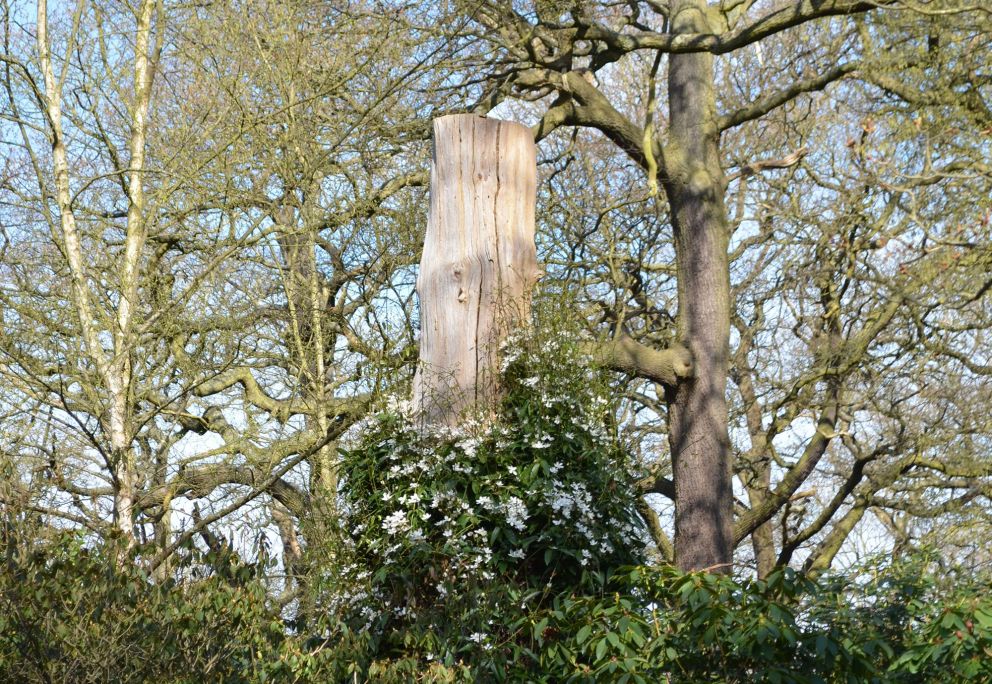 Clematis armandii, an evergreen Clematis with creamy white flowers grows up a dead tree in Beech Bay, the area between Thomson’s Pond and the Main Stream. Rhododendron sutchuense stands above the Still Pond, this outstanding Chinese shrub bears a profusion of large bell-shaped flowers which are a rosy-lilac in colour with purple spots. This Rhododendron is another Ernest Wilson introduction.
Clematis armandii, an evergreen Clematis with creamy white flowers grows up a dead tree in Beech Bay, the area between Thomson’s Pond and the Main Stream. Rhododendron sutchuense stands above the Still Pond, this outstanding Chinese shrub bears a profusion of large bell-shaped flowers which are a rosy-lilac in colour with purple spots. This Rhododendron is another Ernest Wilson introduction.
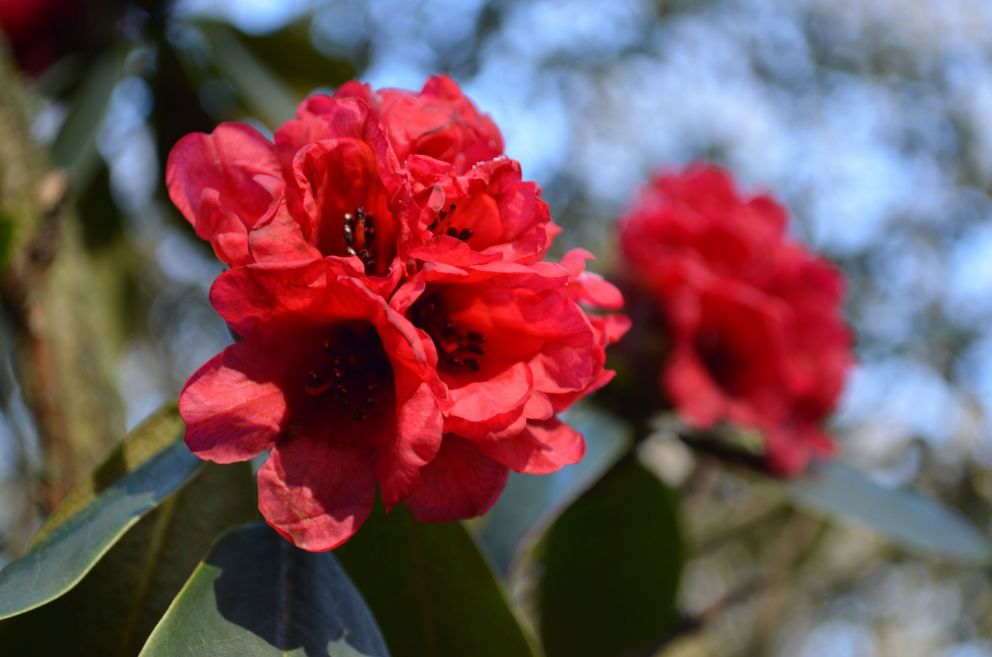 In the ‘V ‘ between the streams area look out for two stunning Rhododendrons grown for both their stunning flowers and bark; Rhododendron shilsonii which has loose trusses of bell shaped blood-red flowers and Rhododendron hylaeum with its pale pink flowers. R.calophytum ‘Robin Hood’ grows above these two rhododendrons, set back off the main stream path and bears large trusses of pale pink bell-shaped flowers with a maroon basal blotch.
In the ‘V ‘ between the streams area look out for two stunning Rhododendrons grown for both their stunning flowers and bark; Rhododendron shilsonii which has loose trusses of bell shaped blood-red flowers and Rhododendron hylaeum with its pale pink flowers. R.calophytum ‘Robin Hood’ grows above these two rhododendrons, set back off the main stream path and bears large trusses of pale pink bell-shaped flowers with a maroon basal blotch.


